Click on a picture to enlarge it
| Snakes in Movies Group Pages |
All Movie Snakes Must Die! |
| All Movie Snakes Want to Kill You! |
| Dancing With Snakes |
| Giant Monster Snakes |
| Pet Snakes |
| Shooting Snakes |
| Snake Bites |
| Snake Charmers |
| Snake Face |
| Snake Fights |
| Snake People |
| Snake Pits |
| SnakeSexploitation |
| Snakes & Skulls |
| Snakes Run Amok |
| Snakes Used as Weapons |
| Snakes Used for Comedy |
| Snakes Used for Food or Medicine |
| Snakes Used Realistically |
| Throwing and Whipping Snakes |
| Kinds of Snakes |
| Rattlesnakes |
| Cobras |
| Black Mambas |
| Boas, Pythons, and Anacondas |
| Kingsnakes and Tricolor Snakes |
| Unusual Species
|
| Settings |
| Snake in the House! |
| Snakes in Beds |
| Snakes in
Jungles and Swamps |
| Snakes In Trees |
| Genres & Locations |
| Snakes In Westerns |
| Snakes in Asian Movies |
| Herps in Australian Movies |
| Herps in James Bond Movies |
| Herps in Silent Movies |
| Herps in Spielberg Movies |
| Snakes in Movies | ||
| Lonesome Dove (1989 TV Miniseries) | ||
| Spoiler Alert ! Some of these pictures and descriptions may give away plot details that you might not want to know before watching the film. |
||
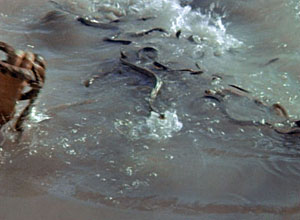 |
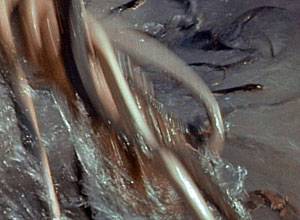 |
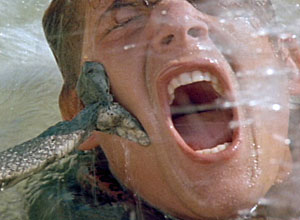 |
| This is a great and beloved Western, adapted from Larry McMurtry's Pulitzer Prize-winning novel into a 9 hour TV mini-series. It has plenty of scenes of cows crossing rivers and a couple of silly snake scenes. At the end of part one of this a group of cowboys is crossing a South Texas river on horseback. One of them is afraid to cross, or maybe his horse is, so he goes last. All of a sudden he is attacked by a bunch of vicious "water moccasins" that come out of nowhere after all of the other cowboys and cows have already crossed at the exact same spot. It's like the snakes were waiting for him. And even crazier than that, the snakes attacked him first instead of his horse. It's worthy of a scene from any of the worst snake horror movies as we see him thrashing around in the water grabbing handfuls of the snakes that are writhing all around him. Finally, one of the snakes bites him on the cheek to end part 1. One cowboy says he's never seen anything like it, and another comments that the recent storm must have stirred up a "nest" of the snakes, in a lame attempt to rationalize the event. This is an ignorant, but sadly common belief - that snakes always congregate into large "nests" or "dens." Some snakes do that in winter when they "hibernate" sharing the same shelter because it is too cold for them, but that doesn't explain this. (See the Movie "Mud" below, and almost any of the snake horror films where herds of snakes invade a town for more of this myth.) Of course, I could be wrong - Harry Greene, the herpetologist who literally wrote the book on snakes, highly praises this film and the novel in his autobiography. (I'm kidding. I doubt he would approve of this snake attack.) Most of these are fake snakes, but it looks like they did put a few live ones in the mix to add some realistic movement, but they were most likely harmless watersnakes which look a lot like Water Moccasins (also called Cottonmouths.) If you search for "Lonesome Dove Snake Scene" on YouTube you might be able to watch the scene. Try this one. |
||
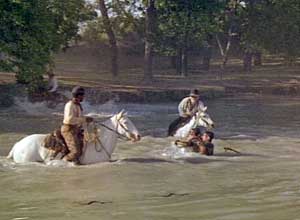 |
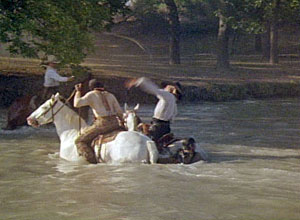 |
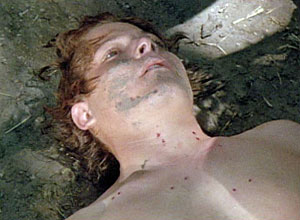 |
| As part 2 begins, several cowboys jump or ride into the river to help the snakebit cowboy, and for some reason the vicious "nest" of seething moccasins leaves them alone even though there are still a few rubber snakes floating on the water. Tommy Lee Jones yanks a snake off the kid and tries to see how far he can throw it. (This marks the invention of the sport of moccasin tossing, which somehow never became popular despite the prevalence of similar snake-killing festivals in Texas called "rattlesnake roundups.") For some odd reason, nobody shoots at the snakes, like they usually do in Westerns. (They shoot at the snakes in the book, so why not here?) When the kid is taken out of the water, we see a whole bunch of double fang-marks on his chest and face, because that's what all snake bites look like in the movies. Apparently, those moccasins really had it in for him. I give some credit to this film because these cowboys don't go around randomly shooting rattlesnakes during the long duration of the film and of their journey just to prove how tough and ready they are, as a lot of movie cowboys do. They save that kind of horrible indiscriminate killing for Native Americans and for lynching outlaws, which, terrible as it is to see, is probably exactly what really happened in the old West. |
||
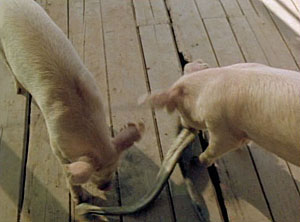 |
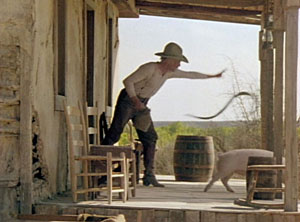 |
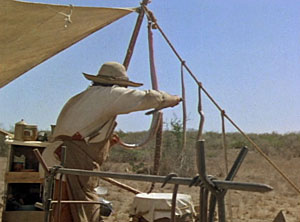 |
| The film opens with a shot of two pigs eating a dead rattlesnake (it looks like a real dead Western Diamond-backed Rattlesnake) on a front porch. Robert Duvall kicks them off the porch, throwing the back half of the snake which they left behind after them. We don't see who killed the snake, but we assume it was the pigs, who go on to be two of the stars of this movie. |
Later in the first of the four episodes, we see a cook skinning a Western Diamond-backed Rattlesnake, one of four that are hanging off one of the ropes to his canvas shelter. When one of the cowboys asks what it's for, Robert Duvall says it's supper, and that it'll make a good stew. | |